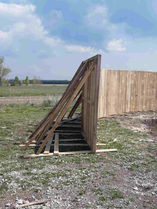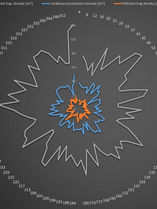
Large Caliber Services
Our specialty: Detonation testing and development support for high explosive warheads.
Our Expertise At A Glance

-
Experimental evaluation of all fragment ballistics parameters: velocity-, mass-, shape-, angle distributions.
-
Standard tests according to international norms: ITOP, STANAG, TOP
-
Numerical simulation of terminal ballistics.
-
Quantification of munition lethality & safety, for soft & hard targets.
-
Insensitive munitions (IM) testing.
-
Support for full development cycle of design, testing, production.
-
Simulation software for fragment ballistics and 6-DOF models.
Our Test Packages
Simple
Our Large Caliber Services are structured into several Test Packages to simplify fragment ballistics for you.
Comprehensive
Each Test Package includes the detonation tests, evaluation and interpretation of the data and comprehensive performance reports.
Flexible
We know each project is unique. That's why we use the Test Packages as a starting point and will extend/adapt them to your exact needs.
01: Lethality & Safety Test Package
Our default comprehensive terminal ballistics test for HE warheads. Carried out as an arena test according to the standards set in ITOP 4-2-81. This test package is used to experimentally determine the full set of angular mass, shape, and velocity distributions, delivering the Z-DATA File of the warhead.
The result of the detonation tests is a detailed Lethality Performance Assessment Report. It provides an in-depth breakdown of the test procedure and results. Specifically, the report will contain:
-
The Z-DATA File,
-
The Mean Area of Effectiveness (MAE), simulated for different detonation scenarios,
-
Lethal Radius,
-
Combat Safety Radius,
-
Danger Radius,
-
Reduced Safety Radius,
An optional extra is the inclusion of hard or soft targets in the arena test setup to determine fragment lethality experimentally, e.g. with wound ballistics.
Typical use cases:
-
Qualification or assessment of a product at the end of development,
-
Lot acceptance tests, required by the customer.
02: Closed Chamber Test Package
Industry-standard closed chamber detonation test in a confined container. The warhead is surrounded by air, followed by a deceleration medium, either sand or water. We consistently recover and analyze > 90% of fragments.
The result of the detonation tests is a comprehensive Closed Chamber Test Report. It provides an in-depth breakdown of the test procedure and results. Specifically, the report will contain:
-
Fragment mass and shape distributions across the ITOP 4-2-813 mass classes,
-
Absolute Safety distance (optional, in connection with arena tests),
-
A metallurgical analysis of the fragments (optional),
-
A fracture analysis of the collected fragments (optional),
-
Preliminary Z-DATA File (optional, in connection with comparative arena tests),
-
Preliminary Mean Area of Effectiveness (MAE), simulated for different detonation scenarios (optional, in connection with comparative arena tests).
This data gives very detailed insights into the exact fragmentation behavior of the warhead. The Z-DATA File and MAE are calculated using reasonable assumptions and averages for any missing experimental data. This makes this package ideally suited to compare test samples during R&D.
Typical use cases:
-
Experimental comparison of prototypes during R&D,
-
Lot acceptance tests, required by the customer.
03: Comparative Lethality Test Package
Quick and cost-effective arena test suite to obtain indicative lethality results. The warheads are detonated in horizontal position inside a simplified half-arena setup. The evaluation includes fragment velocity, as well as the discrimination between lethal and non-lethal fragments, based on an energy threshold model.
The result of the detonation tests is a comprehensive Comparative Lethality Test Report. It provides an in-depth breakdown of the test procedure and results. Specifically, the report will contain:
-
Angular distributions of lethal vs. non-lethal fragments,
-
Angular distribution of fragment velocity,
-
Preliminary Z-DATA File (for relative comparison between different tested warheads),
-
Preliminary Mean Area of Effectiveness (MAE), simulated for different detonation scenarios (for relative comparison between different tested warheads).
An optional extra for this package is the inclusion of hard or soft targets in the arena test setup. This allows for an in-depth terminal ballistics assessment of the fragments with respect to these targets, e.g. with wound ballistics.
The Z-DATA File and MAE are calculated using reasonable assumptions and averages for any missing experimental data. This makes this package very useful to compare test samples during R&D, or to ensure that a production lot meets minimum levels of lethality performance.
Typical use cases:
-
Experimental comparison of prototypes during R&D,
-
Lot acceptance tests, required by the customer.
04: Ejection Symmetry Test Package
Arena test suite to gain precise insights into the detonation symmetry of warheads. The warheads are detonated in vertical position inside a full-arena setup. The evaluation includes the discrimination between lethal and non-lethal fragments, based on an energy threshold model. Optionally, fragment velocity measurements can also be included.
To achieve consistent and predictable performance on the battlefield, a high degree of cylinder symmetry of fragment ejection is required. This test package is used to ensure an equal circumferential distribution of total and lethal fragments. This is essential to rule out possible design or production issues.
The result of the detonation tests is a comprehensive Ejection Symmetry Test Report. It provides an in-depth breakdown of the test procedure and results. Specifically, the report will contain:
-
Circumferential distribution of total fragments,
-
Circumferential distribution of lethal vs. non-lethal fragments,
-
Circumferential distribution of fragment velocities (optional).
Typical use cases:
-
Experimental evaluation of prototypes during R&D,
-
Experimental confirmation during production runs.
05: Statistical Convergence Test Package
Specialized arena test suite to determine the appropriate number of detonations which must be carried out, to achieve statistically valid angular distribution results. The evaluation includes the discrimination between lethal and non-lethal fragments, based on an energy threshold model. Optionally, fragment velocity measurements can also be included.
As ejection symmetry tests routinely show, the circumferential distribution of fragment ejection for warheads can be anything but even in practice. This can be the case despite rigorous efforts during design and production.
The convergence detonation tests are typically carried out before any other arena lethality tests. Through them we can determine:
-
The minimum number of detonations needed for statistically valid results and/or
-
the standard deviations occurring for a specific number of planned detonations.
The result of the detonation tests is a comprehensive Statistical Convergence Test Report. It provides an in-depth breakdown of the test procedure and results. Specifically, the report will contain:
-
A detailed statistical analysis of the deviations in fragment ejection behavior observed for different numbers of detonations,
-
Recommendations on the number of detonations for any planned arena tests on the warhead design.
Typical use cases:
-
Qualification or assessment of a product at the end of development,
-
Determination of statistical validity of pre-existing lethality arena test results.





























